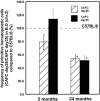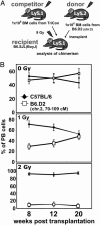Regulation of hematopoietic stem cell aging in vivo by a distinct genetic element
- PMID: 15788535
- PMCID: PMC555968
- DOI: 10.1073/pnas.0408654102
Regulation of hematopoietic stem cell aging in vivo by a distinct genetic element
Abstract
Until recently, stem cells were thought to be endowed with unlimited self-renewal capacity and, thus, assumed exempt from aging. But accumulating evidence over the past decade compellingly argues that a measurable and progressive replicative impairment in the hematopoietic, intestinal, and muscle stem cell activity exists from adulthood to old age, resulting in a decline in stem cell function and rendering stem cell aging as the possible link between cellular aging and organismal aging. By using a previously uncharacterized congenic animal model to study genetic regulation of hematopoietic stem cell aging, we have demonstrated definitively that a locus on murine chromosome 2 regulates hematopoietic stem cell aging. In addition to demonstrating that hematopoietic stem cell aging is regulated by a distinct genetic element, experimental evidence links the response of hematopoietic stem cells to DNA double-strand breaks to cellular aging, suggesting DNA integrity influences stem cell aging.
Figures




Similar articles
-
Age- and stage-specific regulation patterns in the hematopoietic stem cell hierarchy.Blood. 2001 Nov 15;98(10):2966-72. doi: 10.1182/blood.v98.10.2966. Blood. 2001. PMID: 11698278
-
Genetic regulation of primitive hematopoietic stem cell senescence.Exp Hematol. 2000 Apr;28(4):442-50. doi: 10.1016/s0301-472x(99)00157-5. Exp Hematol. 2000. PMID: 10781902
-
A differentiation checkpoint limits hematopoietic stem cell self-renewal in response to DNA damage.Cell. 2012 Mar 2;148(5):1001-14. doi: 10.1016/j.cell.2012.01.040. Cell. 2012. PMID: 22385964
-
Advances in hematopoietic stem cell research through mouse genetics.Curr Opin Hematol. 2006 Jul;13(4):209-15. doi: 10.1097/01.moh.0000231416.25956.35. Curr Opin Hematol. 2006. PMID: 16755215 Review.
-
Aging of hematopoietic stem cells is regulated by the stem cell niche.Exp Gerontol. 2008 Nov;43(11):974-80. doi: 10.1016/j.exger.2008.04.007. Epub 2008 Apr 22. Exp Gerontol. 2008. PMID: 18504082 Review.
Cited by
-
The human brain and its neural stem cells postmortem: from dead brains to live therapy.Int J Legal Med. 2006 Jul;120(4):201-11. doi: 10.1007/s00414-005-0037-y. Epub 2005 Oct 7. Int J Legal Med. 2006. PMID: 16211420 Review.
-
Aging induced decline in T-lymphopoiesis is primarily dependent on status of progenitor niches in the bone marrow and thymus.Aging (Albany NY). 2012 Sep;4(9):606-19. doi: 10.18632/aging.100487. Aging (Albany NY). 2012. PMID: 23047952 Free PMC article.
-
Regulation of spermatogonial stem cell self-renewal in mammals.Annu Rev Cell Dev Biol. 2008;24:263-86. doi: 10.1146/annurev.cellbio.24.110707.175355. Annu Rev Cell Dev Biol. 2008. PMID: 18588486 Free PMC article. Review.
-
Quantitative trait gene Slit2 positively regulates murine hematopoietic stem cell numbers.Sci Rep. 2016 Aug 9;6:31412. doi: 10.1038/srep31412. Sci Rep. 2016. PMID: 27503415 Free PMC article.
-
RBBP9: a tumor-associated serine hydrolase activity required for pancreatic neoplasia.Proc Natl Acad Sci U S A. 2010 Feb 2;107(5):2189-94. doi: 10.1073/pnas.0911646107. Epub 2009 Dec 28. Proc Natl Acad Sci U S A. 2010. PMID: 20080647 Free PMC article.
References
Publication types
MeSH terms
Grants and funding
LinkOut - more resources
Full Text Sources
Other Literature Sources
Medical
Molecular Biology Databases
Miscellaneous

